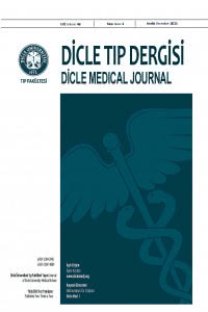Clinicohematological Profile of Pancytopenia: A Study from a Tertiary Care Hospital
Pansitopeninin Klinik ve Hematolojik Profili: Bir Üçüncü Basamak Hastane Çalışması
___
- 1. Raz I, Shinar E, Polliack A. Pancytopenia with hypercel- lular bone marrow a possible paraneoplastic syndrome in carcinoma of lungs: a report of three cases. Am J Hematol 1984;16:403-408. 2. De Gruchy GC: Pancytopenia; Aplastic anemia. In Firkin F, Chestermann C, Penington D (eds). De Gruchys Clinical Haematology in Medical Practice.5th edition. Oxford Uni- versity Press. 1991:p: 119-136. 3. Chhabra A, Chander V, Patel A, et al. Clinico-aetiological profile of pancytopenia in paediatric practice. J Indian Acad Clin Med 2012;13:282-285. 4. International Agranulocytosis and Aplastic Anaemia Study group: Incidence of aplastic anaemia: the relevance of di- agnostic criteria. Blood 1987;70:1718-1721. 5. Verma N, Dash S. Reappraisal of underlying pathology in adult patients presenting with pancytopenia. Trop Geog Med 1992;44:322-327. 6. Jain and Naniwadekar. An etiological reappraisal of pancy- topenia- largest series reported to date from single tertiary care teaching hospital. BMC Hematology 2013;13:10. Doi:10.1186/2052-1839-13-10 7. Naseem S, Varma N, Das R, et al. Paediatric patients with bi- cytopenia/pancytopenia: review of aetiologies and clinico- haematological profile at a tertiary centre. Indian J Pathol Microbiol 2011;54:75-80. 8. Bunch C. Bone marrow failure. Med Int 1995;10:495-499. 9. Jha A, Sayami G, Adhikari RC, et al. Bone marrow ex- amination in cases of pancytopenia. J Nepal Med Assoc. 2008;47:12-17. 10. Kumar R, Kalra SP, Kumar H, et al. Pancytopenia-a six year study. J Assoc Physicians India 2001;49:1078-1081. 11. Khodke K, Marwah S, Buxi G, et al. Bone marrow exami- nation in cases of pancytopenia. J Indian Acad Clin Med 2001:2:55-59. 12. Tilak V, Jain R. Pancytopenia-a clinicohematological analy- sis of 77 cases. Indian J Pathol Microbiol 1999;42:399-404. 13. Chandra J, Jain V, Narayan S, et al. Folate and cobalamin deficiency in megaloblastic anemia in children. Indian Pe- diatr 2002;39:453-457. 14. Jan MA.Thrombocytopenia in children. J Postgrad Med Inst 2004;18:353-358. 15. Menon S, Shaikh S, Nizamani MA. Etiological spectrum of pancytopenia based on bone marrow examination in chil- dren. J Coll Physicians Surg Pak 2008;18:163-167. 16. Khan FS, Hasan RF. Bone marrow examination of pancyto- penic children. J Pak Med Assoc 2012;62:660-663. 17. Imbert M, Scoazec JY, Mary JY, et al. Adult patients pre- senting with pancytopenia: A reappraisal of underlying pa- thology and diagnostic procedures in 213 cases. Hematol Pathol 1989;3:159-167. 18. Keisu M, Ost A. Diagnosis in patients with severe pancyto- penia suspected of having aplastic anemia. Euro J Haema- tol 1990;45:11-14. 19. Khunger JM, Arun selvi S, Sharma U, et al. Pancytopenia-a clinicohematological analysis of 200 cases. Indian J Pathol Microbiol 2002;45:375-379. 20. Latger Cannard V, Bibes B, Dao A, et al. Malaria related cytopenia. Ann Biol Clin 2002;60:213-216. 21. Aouba A, Noguera ME, Clawel JP, et al. Haemophagocytic syndrome associated with plasmodium vivax infection. Br J Haematol 2000;108:832-833. 22. Modan B, Segal S, Shani M, et al. Aplastic anemia in Israel: evaluation of the etiological role of chloramphenicol on a community wide basis. Am J Med Sci 1975;270:441-445.
- ISSN: 1300-2945
- Yayın Aralığı: 4
- Başlangıç: 1963
- Yayıncı: Cahfer GÜLOĞLU
Chest Pain may be the First Symptom of Malignant Tumors in Children: Report of Two Cases
Alper Akın, Meki Bilici, Murat Söker, Bedri Aldudak, Fatih Meteroğlu
Use of Bosentan, Theophylline and Vardenafil in Treatment of Priapism
İhsan UNUS, AHMET KARAKEÇİ, TUNÇ OZAN, Fatih FIRDOLAŞ, İrfan ORHAN
Evaluation of the Newborn Hearing Screening Test Applied in a Secondary Center
Ayşe ÇAKAL, Zerrin AŞCI, Abdulkadir BUCAK, Beyhan YILMAZ, Emel AYTUĞ
Opinions of Operating Room Nurses Regarding Patient and Staff Safety in Operating Room
Çiğdem SEYMAN CANPOLAT, SULTAN AYAZ ALKAYA
The Association between Symptoms of Obstructive Sleep Apnea Syndrome and School Performance
Melike Demir, Pakize Gamze Bucaktepe, Mahsuk Taylan, Süreyya YILMAZ, Halide Kaya, Mehmet Coşkunsel, Gökhan Kırbaş, Cengizhan Sezgi
Zülfü Bayhan, Sezgin Zeren, Mehmet Ekici, Cüneyt Kahraman, Turgay Şimşek
Çoklu organ yetersizliğine yol açan meningokoksemili olguda tedavi seçiminin sağkalım üzerine etkisi
Kadriye ÖZDEMİR, Nida DİNÇEL, Orhan Deiz KARS, Ebru YILMAZ, Gözde GÖZÜOĞLU, Sevgi MİR
Prokinetik Ajanların Proksimal ve Distal Kolon Motilitesi Üzerine Etkileri
Mehmet Şerif ARSLAN, AHMET ALTUN, İhsan BAĞCIVAN, CENGİZ GÜNEY, LEVENT CANKORKMAZ, Gökhan KÖYLÜOĞLU
Oral Hijyen İndeksi ve Gastrik Helicobacter Pylori Pozitifliği İlişkisi
Tolga ÖNDER, TURGUT ANUK, Cihan HEYBELİ
Serum Growth Arrest Specific Protein 6 (Gas-6) Levels in Patients with Schizophrenia
Fethullah GERİN, Aybala TOPRAK, Hayriye ERMAN, Sadettin DÜRÜYEN, Alper BAŞ
